Tracey Cramer-Kelly's Blog, page 18
January 18, 2014
“Happy New Year” Movie is NOT Happy (Here’s Why)
I’ve been watching the progress of the movie “Happy New Year” for quite some time: from its original inception as a one-act play; to a crowdfunding push to turn it into a movie; through the film festival circuit; and (finally) to a physical CD that could be purchased.
I wanted this movie to succeed because the themes are so similar to that of True Surrender. The characters even face similar obstacles: PTSD and amputation.
“Happy New Year” is a fictional story, as is True Surrender. But there’s a vast difference between them.
Sergeant Lewis (like Aaron in True Surrender) has everything go wrong. Without giving too much away, at the core of his PTSD is the guilt he feels for surviving while his compatriots died.
But he also has some things going for him: a supportive ‘roommate’; other veterans who respect him; and he catches the attention of a female doctor-in-training.
He doesn’t quit; he keeps getting on those parallel bars and pushing himself. He goes out to a strip club and gets a lap dance while in his wheelchair (which ends badly). He sticks up for the VA residents. The girl kisses him. I’m thinking: okay, he’s on the way up.
But then he needs another surgery on this leg, and when he wakes, he’s an amputee. From there, to put it frankly, it was a complete downer. It does not end happily. In fact, the end is downright disturbing.
Which was likely the intent. This film had a point to make (veteran suicide); the writer wants you to be affected, to think.
Some will argue that it wouldn’t have the same impact if it had a happily-for-now ending.
Maybe it’s my basic optimism, my belief in faith and the human spirit. Maybe it was the cover photo, which shows a figure in a wheelchair with hands raised and fisted that connotes (to me) victory or, at the least, inner strength and perseverance. Perhaps it was the scenes selected for the trailer (which were the more upbeat ones). Or possibly the description that ends with “Lewis faces his fiercest battle yet” which is coincidentally similar to the description I wrote for True Surrender back in 2011 … that predisposed me to seek a triumph-of-the-spirit theme.
The fact is, I like to see characters suffer (just ask my critique readers!). But then I want to see them rise above their situation, find strength and courage deep within themselves … and triumph. That’s what I want to see in a movie even more so than a book, because a movie is about entertainment and escape.
So, if True Surrender were ever to become a movie, it might have some similar scenes (nightmares for example). But the end would be a lot different – and a lot more satisfying.
January 1, 2014
The Making of an Audiobook: From Newbie to Narrator
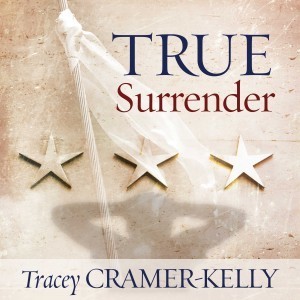 On the first day of a New Year, I’m very excited to share that True Surrender, my military romance novel, is now available in audiobook format!
On the first day of a New Year, I’m very excited to share that True Surrender, my military romance novel, is now available in audiobook format!
To get more information about Army officer Aaron Bricewick’s struggle with PTSD and the amputation of his leg (and the woman who helped him through both), click here.
To experience a free sample – set to photos from the story – click here!
When I first started thinking about True Surrender as an audiobook, I nearly choked on the cost – for narrator, studio and editing it was $1800-$2000 for a full-length novel just about everywhere I checked. (Now I understand why, but I’ll get to that in a minute.)
It was simply out of my reach – especially since I had no idea how to sell an audiobook (heck, I still don’t know how to sell my print/ebooks either!) or if this particular story would appeal to the typical audiobook buyer/listener.
So I shelved the idea until one day I overhead an acquaintance who’s a voracious reader gushing about how she much prefers to hear a story/book directly from the writer’s mouth.
This was a bit of a revelation… narrate my own book?
I googled it (naturally). There were many sites showing steps to narrating your own book, complete with equipment you’d need, etc. So, apparently, it was entirely acceptable to narrate your own book!
Well, heck, I thought, I could do that. I’ve sung vocals for multiple albums, even my own cover songs. I have friends with studios in their homes.
I didn’t want to mess with audio equipment, but if those friends were amenable to helping…Yes, I could be my own narrator. But should I?
To answer that one, I conducted an informal poll of my readers and other authors. I asked them how they felt about the narrator’s voice. And though some preferred an ultra-polished ‘performance,’ many said that since the writer knows her story the best, she would be the best to read it aloud, with emphasis where she’d intended it.
So, in my typical I’ll-try-anything-once attitude, I talked my friend Tim into recording at his studio (I still owe him some help with a video), and we got started.
We did the whole book, stopping to backtrack and re-record if I flubbed, or if we got outside sound (just our luck, the street sweepers were on his street that week!), in a week’s time.
Thanks to a crazy travel schedule, it took me almost 12 weeks to listen to every minute (which turned out to be over 300!) of it, flagging the errors. I went back to his studio and re-recorded the problem areas.
I sent it off to Karen, ‘scrubber extraordinaire,’ to clean up the diction and any low-level humming or background noise we’d missed. She found some that were bad enough I couldn’t let them go, so back to the studio I went. The new files made their way to Karen, who dropped them into the recording and cleaned them up.
The last step was the final ‘mastering’ and upload to Amazon et al. And then – to my surprise – I found I have NO control over the price! (That’s quite a shock after the craziness of the ebook market.) It is apparently set using length guidelines (and True Surrender comes in just over five hours). I’m still on the fence as to whether this is a good thing or not!
So back to the original issue of cost… I completely understand why the costs I encountered were in the $2000 range. It’s almost painful to think of all the hours I could have spent writing a new story instead of making this audiobook. But I prefer to value the recording process for what it was: a new learning experience. And frankly, it’s pretty neat to have yet another way for readers to get to know Aaron and Holly’s story.
You can download True Surrender at Amazon, Audible or iTunes (coming any day now). Or, if you prefer a physical CD, contact me directly (tracey (at) traceycramerkelly.com).
December 12, 2013
Definition of a War Hero: Courage at Home
 Like a lot of people, I fell in love with this couple when I came across their photo on Facebook this fall.
Like a lot of people, I fell in love with this couple when I came across their photo on Facebook this fall.
In the photo, double-amputee and former U.S. Marine Jesse Cottle is being carried on his wife Kelly’s back.
It’s clear in this photo that Jesse chose joy, chose to truly LIVE even after everything he’d seen and experienced … and I had to know more. Because, if you know me, you know that this is an important topic to me (for one thing, it’s the subject of my novel True Surrender).
Jesse enlisted in 2003 and was on his fourth deployment in Afghanistan in 2009. He had a dangerous job – to find and dismantle improvised explosive devices (IEDs) – and that’s what he was doing when he stepped on a pressure plate.
Amazingly, much of this event was captured on film by one of his fellow Marines. That footage – along with interviews of Jesse and the men who were with him that day – was used in the documentary film, “Coming Home” – which I highly recommend watching here: https://vimeo.com/57161439
There are so many definitions of “war hero.” I can’t begin to count them all, but surely Jesse exemplifies at least one of them. Ssgt Patrick Hilty, who was with Jesse that day, put it just the way I would:
“The way that [Jesse] continues to conduct his life is absolutely amazing and for that reason I would consider him a hero.”
Jesse met his wife, Kelly, during his recovery. “I remember being very intrigued by him,” Kelly said. “He was very different and not just because of his legs, just who he was.”
Both Jesse and Kelly are quick to point out that they are not unique. “We represent a lot of people, couples that are going through the same thing,” Kelly says. “It’s an honor to be able to represent that.”
I love it when I find a real-life story that embodies what I try to portray in my writing!
And in a small way, I have Jesse Cottle to thank for the imminent release of the audiobook version of True Surrender (details here). When I read about Jesse, the narration for True Surrender was complete (thanks to my friend Tim C) but I wasn’t sure I should spend the money to have it edited and mastered.
But if Jesse’s story can give someone hope, then perhaps True Surrender can too!
photo credit: Sarah Ledford, ShutterHappy Photography
November 22, 2013
Bad Soldier… Good Medic
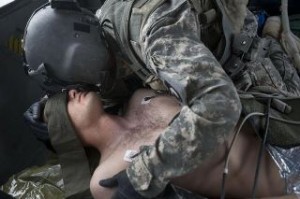 I wasn’t a very good soldier. In fact, people often react with bemused surprise when they find out. “You?” they say. “You took orders from others?”
I wasn’t a very good soldier. In fact, people often react with bemused surprise when they find out. “You?” they say. “You took orders from others?”
Not very well, I admit…but I was young!
I might have made a good officer, though. I was bossy (as three of my younger siblings can attest to) and a bit of a control freak.
But I like to think I was a good medic. Where I responded to Army ‘regiment’ with near-disdain, what I was trained for had the opposite effect: I loved it. I loved splinting a broken leg. Inserting an IV. Dressing a sucking chest wound.
Of course I approached my training with a ‘proper’ level of seriousness…but it was a sort of conceptual play. I joined (just shy of my 18th birthday and straight out of high school) to help pay my way through college (my real aspiration); never in my wildest dreams did I expect to be activated.
Desert Storm changed that. One day I came home to a blink on my answering machine (remember those?) and a message from my Sergeant: “call me immediately.” My friend said I lost all color in my face; my legs went shaky and I had to sit down. Turns out that the Military Police unit that shared our armory had been activated and the purpose for the call was to reschedule our monthly training. For the first time, it occurred to me that I might have to defend our country somewhere half-way around the world. That was not in my plans!
I had a lot of military friends. My BFF was Air Force ROTC, and she introduced me to my college flame, who was also an Air Force cadet. Today an ex-Air Force physician is one of my SMEs (Subject Matter Experts). Good friends from church lost their son in Iraq. And I have many motorcycling acquaintances who are involved with the Patriot Guard.
The Army that I trained in is undoubtedly a different Army now—it has to be. Instead of broken legs, medics deal with amputated limbs. It’s not just bullets that kill; it’s shrapnel and IEDs. Traumatic brain injury—common now—was barely covered in my training.
So how has my experience in the military (and as a medic) affected my writing?
I think everything I write is affected by what I’ve experienced. I tend to view my experiences through a lens that others don’t have (‘how can I use this?’) Yes, there’s a healthy dose of imagination and plenty of creative license, but a seed has to be sown somewhere, and for me it is often the dual experience of military training and medical training.
I made the paramedic heroine of Last Chance Rescue (Jessie) an Iraq war veteran and gave her some of the qualities I saw in my fellow soldiers/medics. I did that because I enjoy writing medical drama, and because it gave her depth and plenty of ways for me to develop her character—and to have an impact on those closest to her (e.g., the hero, Brad).
As I became more fascinated with the inherent conflict between service to country and service to family, Major Aaron Bricewick (hero of True Surrender) came forward, demanding I tell his story. As I wrote it (in 2010), PTSD was just becoming a buzz word. I explored the gut-wrenching experience of “what happens after” in great (and gripping) detail.
And what I’ve found is that I’m profoundly thankful that it wasn’t me out there. At the age of eighteen, I’m just not convinced that I had the maturity to handle what medics do now.
November 2, 2013
Veteran’s Day Reflections – and True Surrender Military Romance for Under a Dollar
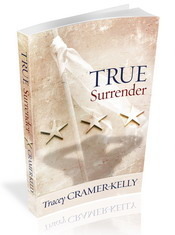 The calendar tells me it is now November. To me, it is November 11 more than Fourth of July or even Memorial Day, that is about remembering our military soldiers.
The calendar tells me it is now November. To me, it is November 11 more than Fourth of July or even Memorial Day, that is about remembering our military soldiers.
Veteran’s Day is only days away. It is also the day I officially released True Surrender (my own story about a wounded veteran) two years ago – a date I specifically picked because of its significance.
This time of year I devote time to reading about real-life soldiers and wounded warriors (obviously a subject of interest to me, since I write about military soldiers, wounded veterans and PTSD). In recent weeks I’ve finished Paradise General by Dr. Dave Hnida and Battle Ready by Mark L. Donald (and I’m currently reading On Call in Hell by Dr. Richard Jadick).
It is Mark’s story I found myself thinking about when I started writing this blog post.
Mark was an ordinary kid growing up poor with an alcoholic father, looking for a way out of his rough neighborhood, when he enlisted first in the Marines, and then the Navy to train as a SEAL and a medic. He truly made something of himself.
Not to say that his journey was direct and easy. As with anything that shows the true courage and character of a person, he was tested mightily.
He spent several chapters describing in detail a pivotal event – the event that likely laid the foundation for his later struggles with PTSD. He talked about friends and colleagues who didn’t make it home, and two friends in particular that he felt he had “failed” to save in his role as a medic.
Yet there were two “forces” in his life that saved him: his mother and his faith.
And the two are closely intertwined.
His mother was a force of nature all in herself; her support for Mark was unlimited, the kind of ‘ferocious love’ mother I think we all wish we had (he says of her: “she had a direct line to God.”). There’s a scene in the book when Mark is at the lowest point in his struggle with PTSD, and out of the blue, she calls. Finally (finally) he admits that he needs help. And she says, “I know, Mijo, that’s why I called you.” It’s a story that shows true humanity, the vulnerability that exists deep inside each of us, as well as the unexpected gifts that appear in our lives when we least expect them.
Which leads me to faith. Mark’s mom was dealt a tough hand, yet her faith seemed unshakeable, and in the end, Mark has his own realization about his faith: “A belief in mankind wasn’t strong enough to hold it together… Without a resilient foundation the bricks came tumbling down.” We can’t put all our belief into ourselves or other human beings; we are all fallible and at some point, we will disappoint even those we love the most.
I often have my characters grapple with faith, especially in True Surrender, the story of an amputee veteran who returns home to find that he has yet to face his biggest battle: the battle within himself.
Faith and sensuality (and even sex outside of marriage) exist side-by-side in my novels. My avid readers are those who appreciate that these co-exist in our own lives; who hasn’t questioned their faith in the darkest times of our own lives? Why should a character in a novel be any different?
Which leads me to a special offer.
I want more people to experience the story of Major Aaron Bricewick in True Surrender. How low a person can go, as well as how the presence of a special person in their life can help them find their own triumph of spirit. (Is it too much to hope that a real-life wounded veteran might be inspired to explore faith him- or herself?)
For a limited time, I am offering True Surrender for just 99 cents. Click here to see how to get your download code and instructions. Hurry – offer only good through November 12!
October 10, 2013
What Does Take Two Heroine Have in Common With P!nk
 I recently came across this photo of Rock Star P!nk riding her motorcycle with her husband, motocross racer Carey Hart. She and Hart have reportedly had several “unusual” dates wherein they ride together (I question the “unusual” part since my hubby and I think it’s aces to get a ride in together!).
I recently came across this photo of Rock Star P!nk riding her motorcycle with her husband, motocross racer Carey Hart. She and Hart have reportedly had several “unusual” dates wherein they ride together (I question the “unusual” part since my hubby and I think it’s aces to get a ride in together!).
P!nk may be following in this photo, but she’s a biker chick in her own right. In fact, she recently led the sixth annual “Ride to the Flags” motorcycle ride, which was organized to benefit a wounded Marine Sergeant.
Motorcycles feature in her recent music video “Blow Me (One Last Kiss),” and in the music video for “There You Go” she rides a motorcycle – and then puts it through a window!
It’s hard to think of any other singer who puts herself out there, who lays it on the line like P!nk does. Her relationship with Hart has provided fodder for many of her songs including “Please Don’t Leave Me” and “So What.”
I think it’s safe to say that P!nk is not your typical Rock Star follow-along. She doesn’t let anyone dictate to her.
Much like Gina in Take Two.
Gina is a damn good Hollywood director, but off set, she does her own thing – and that includes riding a Harley-Davidson motorcycle. There is just something about women riders that screams “independent woman coming through!” Feisty, witty, and taking life on their own terms.
And then there are the men. P!nk has Hart… and Gina has Zac. Of course, since he’s not a biker when Gina meets him, it’s going to take some work to get Zac up to Carey’s level… (Book Details Here)
September 21, 2013
Will Zac Become a Celebrity Biker like Bradley Cooper?
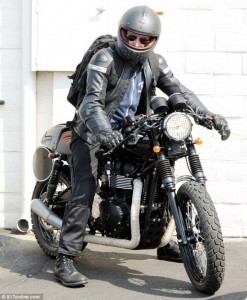 According to IMDb, Hollywood actor Bradley Cooper shot to fame in Wedding Crashers and The Hangover and was nominated for an Oscar award for Silver Linings Playbook.
According to IMDb, Hollywood actor Bradley Cooper shot to fame in Wedding Crashers and The Hangover and was nominated for an Oscar award for Silver Linings Playbook.
The actor’s latest film is American Hustle (a followup to Silver Linings), but I was most intrigued by a movie in which he co-starred with Ryan Gosling: The Place Beyond the Pines (which I think I should view and write a whole separate post about!).
In Pines, Ryan Gosling plays a motorcycle stunt man leaving a particular legacy to his newly-discovered infant son. Bradley Cooper is the cop who’s got to bring him down. It is “a sweeping emotional drama powerfully exploring the unbreakable bond between fathers and sons.” More here.
In real life Bradley Cooper apparently loves the adrenaline rush of riding. Here’s a shot of him on one of his many motorcycles (he appears to favor BMWs). From what I’ve seen, he always wears a helmet (good choice), jacket and gloves – even during scorching heat in L.A. Looks like he’s intent on protecting all those “assets” he makes a living with!
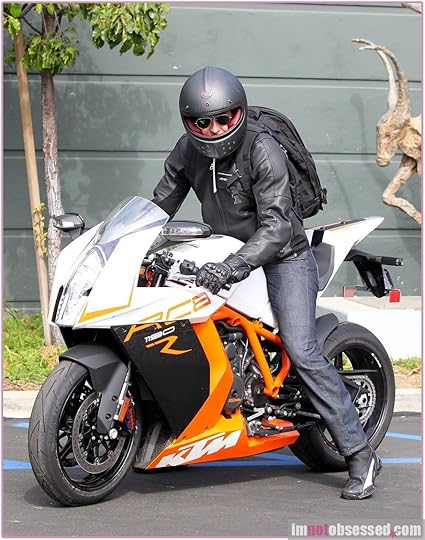 Bradley says he uses his motorcycle rides to think, adding that while his life is full of people he often feels alone. Bradley says when he needs to decompress after the craziness of shooting a film, he’ll ride his motorcycle at two in the morning when the city is completely empty.
Bradley says he uses his motorcycle rides to think, adding that while his life is full of people he often feels alone. Bradley says when he needs to decompress after the craziness of shooting a film, he’ll ride his motorcycle at two in the morning when the city is completely empty.
In Take Two, Gina Devereaux rides her Harley-Davidson to manage the stresses of being a single parent and a Hollywood director. Hollywood actor Zac Davies gets his first taste of riding as a passenger on the back of her motorcycle. And he discovers what we bikers already know: riding is a catharsis. “Out there you don’t think about your shit,” he says.
Then he meets Gina’s biker friends, and, let’s just say (without giving too much away) that by the end of the book he’s well into a transformation to biker dude!
So the question is: will he turn into a Bradley Cooper? 
September 7, 2013
The People You Meet at Harley-Davidson Events
I spent six days in Milwaukee at the Harley-Davidson 110th Anniversary, selling the motorcycle accessories that our family business (Leader Motorcycle) manufactures. It was pretty much all work (I don’t have the energy to go out at night after 12 hours on my feet in the heat and noise). But the thing about being in that business is that I meet the coolest people even when I’m working!
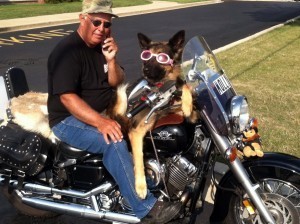
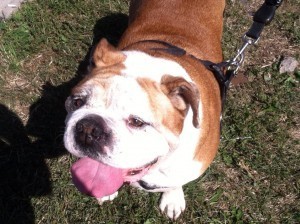 Bikers and their pets. It’s amazing how many animals I see riding around with their humans. I’ve posted photos on Leader’s Facebook page, but in Milwaukee I came across this roly-poly girl (she was licking my ankle) and this goggle-eyed guy draped over his human’s motorcycle.
Bikers and their pets. It’s amazing how many animals I see riding around with their humans. I’ve posted photos on Leader’s Facebook page, but in Milwaukee I came across this roly-poly girl (she was licking my ankle) and this goggle-eyed guy draped over his human’s motorcycle.
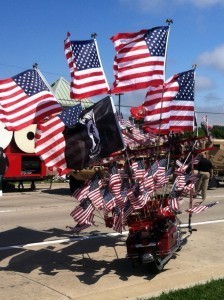
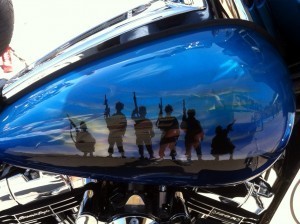 Soldiers. House of Harley hosted a Military Day, complete with displays from local units and a parade. I found this ‘flag pincushion’ motorcycle that day, as well as this amazing tank art. Motorcycles and patriotism seem to go together, and I love it that way (watch for more of that in my future stories).
Soldiers. House of Harley hosted a Military Day, complete with displays from local units and a parade. I found this ‘flag pincushion’ motorcycle that day, as well as this amazing tank art. Motorcycles and patriotism seem to go together, and I love it that way (watch for more of that in my future stories).
Musicians. What are the odds we’d be placed next-door to a songwriter/musician (from my local area, no less!). It was a bonus for me, since I’m a musician myself. Tom has written over 50 songs, but his main goal in participating at this event was to get exposure for his song, “Harley David’s Son” – from people and from Harley-Davidson!
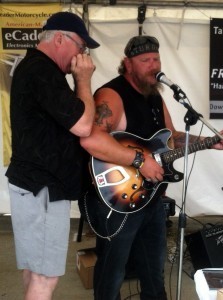 Tom had this habit of inviting passing musicians into his booth to play and sing for us (as shown in this picture) so we were never bored even if the crowds were thin. The local TV station even interviewed him!
Tom had this habit of inviting passing musicians into his booth to play and sing for us (as shown in this picture) so we were never bored even if the crowds were thin. The local TV station even interviewed him!
You can download his song for FREE right now, but I don’t know how long that will last. If I ever get a band together, we are SO covering this song!
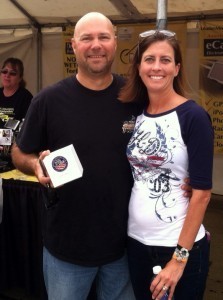
 Friends. I tried to talk my new friend Rhonda out of this ‘girlie’ motorcycle in the parking lot of our hotel… but she didn’t go for it (I thought it would go great with the new helmet I got from my hubby for my birthday this year). And then there’s ‘old’ friends; Leader has a reputation for high-quality products and service and we get a lot of repeat customers like this couple!
Friends. I tried to talk my new friend Rhonda out of this ‘girlie’ motorcycle in the parking lot of our hotel… but she didn’t go for it (I thought it would go great with the new helmet I got from my hubby for my birthday this year). And then there’s ‘old’ friends; Leader has a reputation for high-quality products and service and we get a lot of repeat customers like this couple!
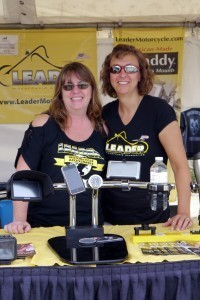 Oh, and the ‘photo gallery’ wouldn’t be complete without one of me and my mate (and Leader office manager), Lynne.
Oh, and the ‘photo gallery’ wouldn’t be complete without one of me and my mate (and Leader office manager), Lynne.
 At the end of the day… just when I thought I was exhausted and couldn’t handle one more day (the last day!) and was missing my kids… a Double Rainbow over our tent! Wow, I couldn’t have asked for a better sign that I was right where I was supposed to be: with the Bikers.
At the end of the day… just when I thought I was exhausted and couldn’t handle one more day (the last day!) and was missing my kids… a Double Rainbow over our tent! Wow, I couldn’t have asked for a better sign that I was right where I was supposed to be: with the Bikers.
If you like biker events or the biker lifestyle, I do think you’d like my latest novel, Take Two: a Hollywood Romance. It’s the first book in my Lady Biker Series and stars a Harley-riding Hollywood director and an up-and-coming heartthrob actor!
 Like What You Read? SUBSCRIBE TO MY BLOG to receive new posts. Click here.
Like What You Read? SUBSCRIBE TO MY BLOG to receive new posts. Click here.
August 28, 2013
Grandpa in a Purple Speedo: Does an Article of Clothing have Special Meaning?
 Recently, I took my kids to the local water park. There, amongst the throngs of mostly kids, I observed a man, approximately 70 years old, wearing a purple Speedo.
Recently, I took my kids to the local water park. There, amongst the throngs of mostly kids, I observed a man, approximately 70 years old, wearing a purple Speedo.
Yes, Speedo. Yes – purple.
Now, I’m about as far from a fashion maven as it’s possible to be, but I haven’t seen many Speedos in recent years (like twenty or thirty!). And perhaps, at that age, a Speedo might not be the most flattering thing to wear (ahem).
Naturally I wondered at his choice. Perhaps that Speedo made him feel younger? Stronger? Maybe the Speedo had meaning to that old guy?
Now, a movie star (like Zac Davies in my novel Take Two) could probably pull off a purple Speedo and still look amazing (he’s a movie star, duh). But there actually IS a particular piece of clothing that turns out to have meaning to the characters. (And no, it’s not a Speedo!)
Without giving too much away, I’ll tell you that Gina (the heroine) gave this article of clothing to Zac while he was in dialysis. That piece of clothing shows up in several scenes in the book. In one instance, it becomes an anchor he clings to during a particularly bad time; in another it serves to highlight a physical aspect of Zac that Gina is very drawn to.
But… back to the Purple Speedo.
This older gentleman had a female companion who was probably close to that age, who was wearing a bikini. She was quite skinny with wizened skin and breasts that were, well, just not natural. But I have to hand it to them: they looked like they were enjoying themselves. So who am I to judge? My idea of fun just happens to involve two wheels and a lot of chrome (and tighty whities instead of Speedos)!
August 21, 2013
Public Service as “Therapy” for PTSD
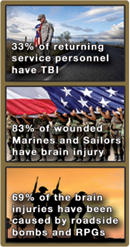 When a soldier is injured and sent home, he/she loses a close brotherhood and intense purpose and is dropped into a society where they are no longer part of something larger than themselves.
When a soldier is injured and sent home, he/she loses a close brotherhood and intense purpose and is dropped into a society where they are no longer part of something larger than themselves.
Yet, when wounded veterans are asked what they want to do when they recover, most of them say they want to return to their units. And if they can’t, they want to serve in some other way – teaching, coaching or working in the community. (A 2009 study of recent veterans showed 92% had a desire to continue to serve in some way.)
I would dare to say: they want to be needed.
How does service help a soldier cope with PTSD? It’s obvious to me: If you’re out doing disaster relief, you’re more likely to be thinking about something other than your own woes!
Perhaps if Major Aaron Bricewick, hero of True Surrender, had access to this option, things might have been different for him. He was torn from his support structure and forced to start over and adjust to live and career as an amputee. He tried to manage his PTSD first with medication (leading to a mild addiction) and then by a fanatical adherence to exercise.
But when his involvement was needed to bring down the ‘bad guy,’ it gave him a sense of purpose and encouraged him to start rebuilding his life. (The love of a good woman plays a part too, of course.)
There’s a hunger for this kind of contribution to others – and not just amongst veterans. In 2011 there were 582,000 applications for 82,000 slots in AmeriCorps (the federal government’s volunteer service program).
This is not rocket science. Why is this realization an “epiphany” to certain sectors (like our government)?
Why it is taking so long for government to get on board with this idea? Organizations like Team Rubicon and Team Red White & Blue (and dozens of others) are stepping into the void. Founders – often wounded vets themselves – are using their own combat and disability pay to get these programs off the ground.
One organization, The Mission Continues, uses a fellowship to organize and fund veterans to do 6-month stints of disaster work and other community service. Fellows take four classes a year and have a weekend orientation at which they get to meet one another. They do a service project together and take an oath of service before returning to their communities. They even complete personal-development reading/writing assignments each month during their transition to civilian life.
An initial study of TMC fellows showed dramatic improvement in well-being after their fellowship. Talk about a win-win situation. Isn’t there a way we can fund more of this?




